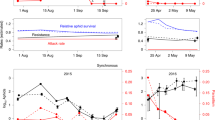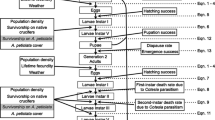Summary
I present an inclusive-fitness model for the evolution of dispersal rates of the offspring of asexual organisms living in discrete sites, which vary in available resources. I also assume a stable and saturated condition and that the offspring can respond to the variation in the capacity (amount of resources) of their natal sites. The model was tested using data obtained from the intergall migration in the yezo-spruce gall aphid,Adelges japonicus. All the parameters needed for the model, which included the cost of dispersal, both dispersal rates and available resources in each site, were estimated from field examinations. The data fit the model well, suggesting the importance of kin selection in determining the dispersal rates. Both actual and ESS dispersal rates are shown as concave functions of site capacity with a minimum rate for intermediate site capacity. The effect of both actual and ESS dispersal is to reduce, but not eliminate sibling competition within natal sites, which is most severe in intermediate site capacity.
Similar content being viewed by others
References
Aoki, S. (1979) Dimorphic first instar larvae produced by the fundatrix ofPachypappa marsupialis (Homoptera: Aphidoidea).Kontyu 47 390–8.
Aoki, S. (1980) Aphid drifting between galls and Hamilton—May's model on dispersal.Biol. Sci. 32, 131–5. (In Japanese.)
Cohen, D. (1967) Optimization of seasonal migratory behavior.Am. Nat. 101, 5–17.
Cohen, D. and Motro, U. (1989) More on optimal rates of dispersal: taking into account the cost of the dispersal mechanism.Am. Nat. 134, 659–63.
Comins, H.N., Hamilton, W.D. and May, R.M. (1980) Evolutionarily stable dispersal strategies.J. Theor. Biol. 82, 205–30.
Crespi, B.J. and Taylor, P.D. (1990) Dispersal rates under variable patch density.Am. Nat. 135, 48–62.
Frank, S.A. (1986) Dispersal polymorphisms in subdivided populations.J. Theor. Biol. 122, 303–9.
Hamilton, W.D. and May, R.M. (1977) Dispersal in stable habitats.Nature 269, 578–81.
Harper, J.L. (1977)Population Biology of Plants. Academic Press, London.
Johnson, M.L. and Gaines, M.S. (1990) Evolution of dispersal: theoretical models and empirical tests using birds and mammals.Ann. Rev. Ecol. Syst. 21, 449–80.
Kadmon, R. and Shmida, A. (1990) Spatiotemporal demographic processes in plant populations: an approach and a case study.Am. Nat. 135, 382–97.
Kuno, E. (1981) Dispersal and the persistence of populations in unstable habitats: a theoretical note.Oecologia 49, 123–6.
Levin, S.A., Cohen, D. and Hastings, A. (1984) Dispersal strategies in patchy environments.Theor. Pop. Biol. 26, 165–91.
Motro, U. (1982a) Optimal rates of dispersal. I. Haploid populations.Theor. Pop. Biol. 21, 394–411.
Motro, U. (1982b) Optimal rates of dispersal. II. Diploid populations.Theor. Pop. Biol. 21, 412–29.
Motro, U. (1991) Avoiding inbreeding and sibling competition: the evolution of sexual dimorphism for dispersal.Am. Nat. 137, 108–15.
Ozaki, K. (1992) Reproductive schedule of the fundatrices ofAdelges japonicus (Monzen) (Homoptera: Adelgidae) in relation to host phenology.Appl. Entomol. Zool. 27, 407–12.
Ozaki, K. (1993) Effects of gall volume on survival and fecundity of gall-making aphidsAdelges japonicus (Homoptera: Adelgidae).Res. Pop. Ecol. 35, 273–85.
Ozaki, K. (1994) Role of fundatrix and gallicola in the gall formation inAdelges japonicus (Monzen) (Homoptera: Adelgidae).J. Appl. Entomol. 118, 151–7.
Roff, D.A. (1975) Population stability and the evolution of dispersal in a heterogeneous environment.Oecologia 19, 217–37.
Setzer, R.W. (1980) Intergall migration in the aphid genusPemphigus.Ann. Ent. Soc. Am. 73, 327–31.
Stenseth, N. (1983) Causes and consequences of dispersal in small mammals. InThe ecology of animal movement (I.R. Swingland and P.J. Greenwood, eds), pp. 63–101. Oxford University Press, Oxford.
Taylor, P.D. (1988) An inclusive fitness model for dispersal of offspring.J. Theor. Biol. 130, 363–78.
Author information
Authors and Affiliations
Rights and permissions
About this article
Cite this article
Ozaki, K. Intergall migration in aphids; a model and a test of ESS dispersal rate. Evol Ecol 9, 542–549 (1995). https://doi.org/10.1007/BF01237835
Issue Date:
DOI: https://doi.org/10.1007/BF01237835




